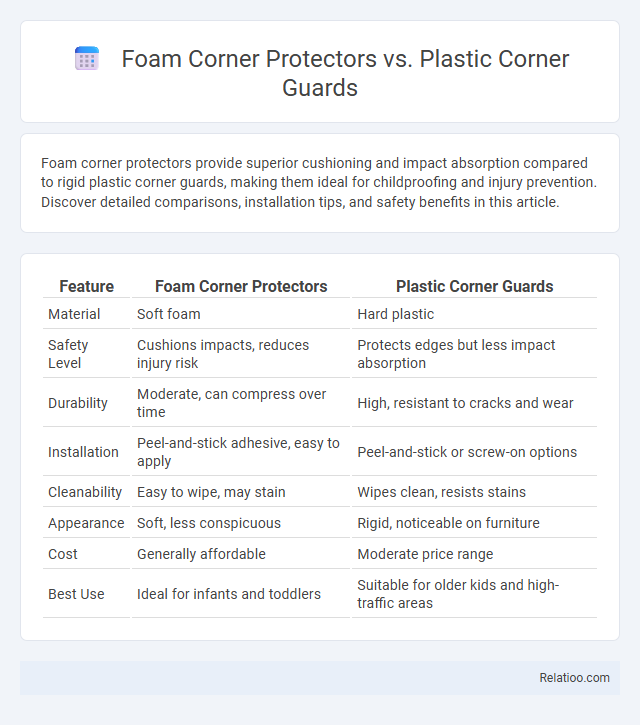Foam corner protectors provide superior cushioning and impact absorption compared to rigid plastic corner guards, making them ideal for childproofing and injury prevention. Discover detailed comparisons, installation tips, and safety benefits in this article.
Table of Comparison
| Feature | Foam Corner Protectors | Plastic Corner Guards |
|---|---|---|
| Material | Soft foam | Hard plastic |
| Safety Level | Cushions impacts, reduces injury risk | Protects edges but less impact absorption |
| Durability | Moderate, can compress over time | High, resistant to cracks and wear |
| Installation | Peel-and-stick adhesive, easy to apply | Peel-and-stick or screw-on options |
| Cleanability | Easy to wipe, may stain | Wipes clean, resists stains |
| Appearance | Soft, less conspicuous | Rigid, noticeable on furniture |
| Cost | Generally affordable | Moderate price range |
| Best Use | Ideal for infants and toddlers | Suitable for older kids and high-traffic areas |
Introduction to Corner Protection Solutions
Foam corner protectors provide soft cushioning, reducing injury risk from sharp edges, ideal for households with toddlers and infants. Plastic corner guards offer durable, easy-to-clean coverage for furniture edges, suitable for maintaining aesthetic appeal while enhancing safety. Childproofing solutions combine these protective elements to create a safer environment, preventing common household accidents involving corners and sharp surfaces.
What Are Foam Corner Protectors?
Foam corner protectors are soft, cushioned safety devices designed to cover sharp edges on furniture, preventing injuries from accidental bumps or falls. Unlike plastic corner guards, foam protectors absorb impact more effectively, offering superior protection for children and adults alike. You can easily install these lightweight, flexible foam guards on tables, countertops, and other corners to enhance your home's childproofing measures.
Understanding Plastic Corner Guards
Plastic corner guards offer a durable and easy-to-clean solution for childproofing sharp edges, providing effective protection against injuries in homes and offices. Unlike foam corner protectors, plastic guards maintain their shape under impact and resist dirt, making them a long-lasting safety option. You can enhance your environment's safety with clear or colored plastic corner guards that blend seamlessly with furniture while preventing accidents.
Key Differences Between Foam and Plastic Options
Foam corner protectors provide softer cushioning that absorbs more impact, making them ideal for children's safety by minimizing injury risk, while plastic corner guards offer more rigid, durable protection and are easier to clean, suited for high-traffic areas. Your choice depends on the balance between comfort and durability; foam is gentle but may wear out faster, whereas plastic is long-lasting but less forgiving upon impact. Considering the material density and installation ease will help you select the best childproofing solution tailored to your needs.
Safety and Impact Absorption Comparison
Foam corner protectors offer superior impact absorption with their soft, cushioned material, effectively reducing injury risk from sharp edges, making them ideal for childproofing your home. Plastic corner guards provide durable protection but lack the same level of shock absorption, often resulting in less effective safety against impacts. For maximum child safety, choosing foam corner protectors ensures your furniture edges are cushioned to prevent harm during accidental bumps.
Installation and Ease of Use
Foam corner protectors offer simple, peel-and-stick installation with soft cushioning that reduces injury risk, making them ideal for quick, temporary childproofing solutions. Plastic corner guards require screwing or adhesive mounting, providing durable protection but demanding more installation effort and tools. Your choice depends on balancing ease of use with long-term safety needs, as foam is user-friendly and effective for immediate use, while plastic guards offer sturdier, lasting corner protection.
Aesthetic Appeal and Design Choices
Foam corner protectors offer a soft, cushioned barrier with a minimalist design ideal for blending into home interiors, while plastic corner guards provide a hard, durable shield available in various colors and finishes to match furniture styles. Childproofing solutions emphasize safety but often compromise on aesthetics, making foam options preferable for those seeking a balance between protection and decor. Selecting corner guards involves considering material transparency, texture, and color to enhance both visual appeal and functional safety in childproofing.
Durability and Maintenance Considerations
Foam corner protectors offer moderate durability but may compress or tear over time, requiring regular replacement and simple cleaning with a damp cloth. Plastic corner guards provide superior durability due to their rigid structure, resisting impact and wear, and can be easily maintained by wiping with household cleaners. When selecting corner protectors for childproofing, consider the trade-off between foam's cushioning benefits and plastic's longevity and ease of maintenance for optimal safety and convenience.
Cost-Effectiveness and Value
Foam corner protectors offer an affordable and easy-to-install solution for childproofing sharp edges, providing excellent cushioning at a low cost. Plastic corner guards, while slightly more expensive, provide durable protection and a sleek appearance that withstands wear and tear better over time. Your choice should balance upfront cost with the longevity and safety value, ensuring effective protection for your family's needs.
Choosing the Right Corner Protection for Your Needs
Foam corner protectors offer soft, cushioned safety ideal for preventing injuries in homes with toddlers, absorbing impact on sharp edges effectively. Plastic corner guards provide durable, easy-to-clean protection suited for high-traffic areas and commercial settings, with a variety of designs to match different aesthetics. Choosing the right corner protection depends on your environment, safety requirements, and whether you prioritize comfort, durability, or style in childproofing solutions.

Infographic: Foam Corner Protectors vs Plastic Corner Guards
 relatioo.com
relatioo.com